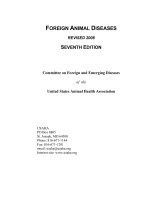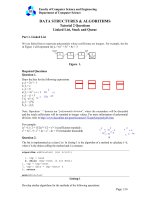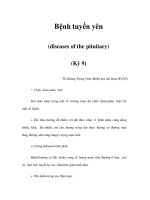Chapter 091. Benign and Malignant Diseases of the Prostate (Part 9) pdf
Bạn đang xem bản rút gọn của tài liệu. Xem và tải ngay bản đầy đủ của tài liệu tại đây (14.4 KB, 5 trang )
Chapter 091. Benign and Malignant
Diseases of the Prostate
(Part 9)
Antiandrogens
Nonsteroidal antiandrogens such as flutamide, bicalutamide, and nilutamide
block the binding of androgens to the receptor. When an antiandrogen is given
alone, testosterone levels remain the same or increase. Compared to testosterone-
lowering therapies, antiandrogens cause fewer hot flashes, less of an effect on
libido, less muscle wasting, fewer personality changes, and less bone loss.
Gynecomastia remains a significant problem but can be alleviated in part by
tamoxifen.
Antiandrogens were approved initially to block the flare that results from
GnRH analogue administration. They have also been studied as monotherapy and
as part of a combined androgen blockade (also called maximal androgen
blockade). Most reported randomized trials suggest that the cancer-specific
outcomes are inferior when antiandrogens are used alone. Bicalutamide, even at
150 mg (three times the recommended dose), was associated with a shorter time to
progression and inferior survival compared to surgical castration for patients with
established metastatic disease. Nevertheless, some men may accept the trade-off of
a potentially inferior cancer outcome for an improved quality of life.
Combined androgen blockade—the administration of an antiandrogen plus
a GnRH analogue or surgical orchiectomy—was designed to inhibit both testicular
and adrenal androgens at the outset. Cumulative results of randomized
comparisons involving thousands of patients showed no advantage for combining
an antiandrogen with surgical orchiectomy, while separate analyses of trials
combining an antiandrogen with a GnRH analogue have shown a modest (<10%)
survival advantage. Meta-analysis of all combined androgen blockade trials
concluded that the approach was not more effective. In practice, most patients
treated with a GnRH analogue receive an antiandrogen for the first 2–4 weeks of
treatment to protect against the flare.
Intermittent Hormone Therapy
Another way to reduce the side effects of androgen depletion is to
administer hormones on an intermittent basis. This was proposed as a way to
prevent the selection of cells that are resistant to androgen depletion. The
hypothesis is that by allowing endogenous testosterone levels to rise, the cells that
survive androgen depletion will induce a normal differentiation pathway. In this
way, the surviving cells that are allowed to proliferate in the presence of androgen
will retain sensitivity to subsequent androgen depletion. Applied in the clinic,
androgen depletion is continued for 2–6 months beyond the point of maximal
response. Once treatment is stopped, endogenous testosterone levels increase, and
the symptoms associated with hormone treatment abate. PSA levels also begin to
rise, and at some level treatment is restarted. With this approach, multiple cycles
of regression and proliferation have been documented in individual patients. It is
unknown whether the intermittent approach increases, decreases, or does not
change the overall duration of sensitivity to androgen depletion. The preliminary
reports suggest that the approach is safe, but long-term data are needed to assess
the course in men with low PSA levels. A trial to address this question is ongoing.
Outcomes of Androgen Depletion
The antiprostate cancer effects of the various androgen depletion strategies
are similar, and the clinical course is predictable: an initial response, then a period
of stability in which tumor cells are dormant and not proliferating, followed after a
variable period of time by a rise in PSA and regrowth that is visible on a scan as a
castration-resistant lesion. Androgen depletion is not curative because cells that
survive castration are present when the disease is first diagnosed. Considered by
disease manifestation, PSA levels return to normal in 60–70% of patients, and
measurable disease regression occurs in 50%; improvements in bone scan occur in
25% of cases, but the majority remains stable. Duration of survival is inversely
proportional to disease extent at the time androgen depletion is first started.
An active question is whether hormones should be given in the adjuvant
setting after surgery or radiation treatment of the primary tumor or at the time that
a PSA recurrence is documented, or to wait until metastatic disease or symptoms
of disease are manifest. Trials in support of early therapy have often been
underpowered relative to the reported benefit or have been criticized on
methodologic grounds. One trial, although it showed a survival benefit for patients
treated with radiation therapy and 3 years of androgen depletion relative to
radiation alone, was criticized for the poor outcomes of the control group. Another
showing a survival benefit for patients with positive lymph nodes who were
randomized to immediate medical or surgical castration compared to observation
(p = .02) was criticized because the confidence intervals around the 5- and 8-year
survival distributions for the two groups overlapped. A large randomized study
comparing early to late hormone treatment (orchiectomy or GnRH analogue) in
patients with locally advanced or asymptomatic metastatic disease showed that
patients treated early were less likely to progress from M0 to M1 disease, to
develop pain, and to die of prostate cancer. This trial was criticized because
therapy was delayed "too long" in the late-treatment group. When patients treated
by radical surgery, radiation therapy, or active surveillance were randomly
assigned to receive bicalutamide, 150 mg, or placebo, hormone treatment
produced a significant reduction in the proportion of patients who developed
osseous metastases at 2 years (9% for bicalutamide; 13.8% for placebo). This
result has not gained acceptance in part because too many "good-risk" patients
were treated and because no effect on survival was demonstrated. These criticisms
are valid; however, the net influence on survival from early hormone intervention
is similar to that observed in patients with breast cancer, for which adjuvant
hormonal therapy is routinely given.









